Japan is a land of forests. Sixty seven percent of the country is covered with trees, only second behind Finland when ‘developed’ nations are compared. Currently the forests are vibrant and green, you can’t help but notice them on the mountains and in the Shrine and Temple forests as you travel around. Both mountains and trees are worshipped in Japan to varying degrees. Given the abundance of forests it is not surprising that wood and related materials play such an important cultural role. This is the element that has particularly caught my attention during late June and early July 2016. Here are my impressions, once again a diverse mix. The many connections between wood and fire demonstrates the inter-relatedness of the elements. As always with these informal posts, it is only part of the story.
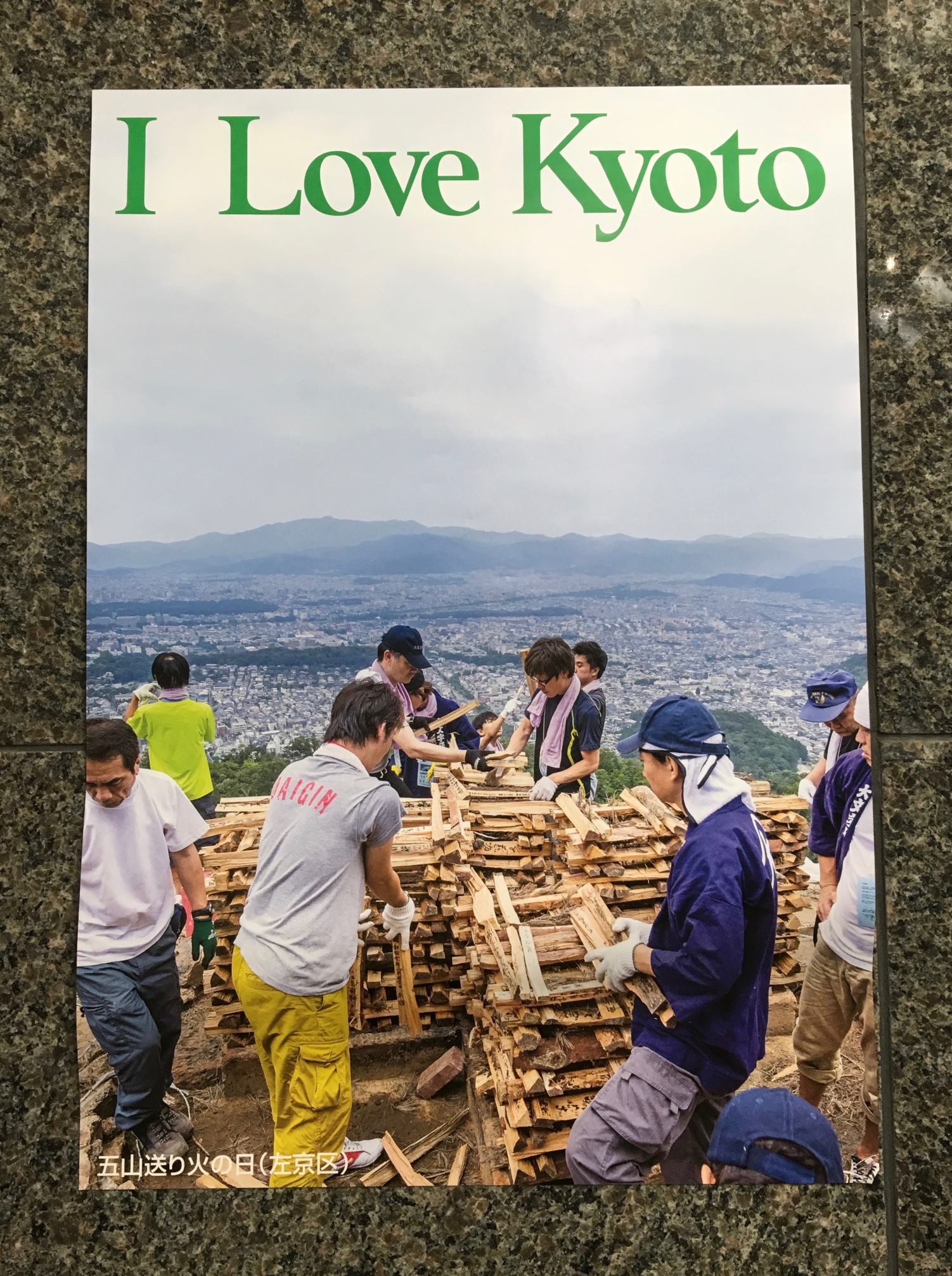
This intriguing poster is one of the reasons the element of wood has recently been to the fore in my mind. I came across it in a railway station mall near the Kyoto City Hall. It appears that the wood will be used for the Daimonji fire festival in mid-August that lights up the hills of Japan’s ancient capital, and of which people in Kyoto are justifiably proud. Forested mountains can be seen in the background of the poster, as well as forests found in shrines, temples, palace grounds and recreational areas in the city basin itself.
Wood/trees is an element in the Chinese five element/phase system, referred to as Wu Xing in China and Gogyo in Japan. The Chinese framework has generating and overcoming cycles between the elements of earth, water, fire, metal and wood. Wood generates fire and overcomes earth. In turn, metal overcomes wood, which is generated by water. Wood has generated fire in Japan for millennia, in both controlled and uncontrolled forms.
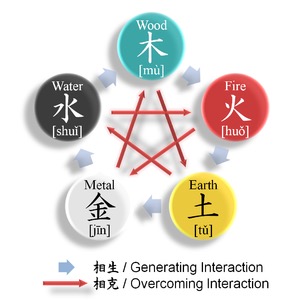
The Wu Xing cycle of five elements/phases from Wikipedia. The words in square brackets are Chinese, the Japanese equivalents are mizu or sui for water; hi or ka for fire; chi, tsuchi or ji for earth; kin for metal, and ki for wood. Wu Xing (gogyo) and yinyang (inyo) are closely related. They have a long history in Japan, especially in the context of Onmyodo, or InYodo – translated as the way of Yin and Yang. These five elements are an essential component of fusui, the Japanese equivalent of feng shui – a practice used in Japan for nearly 1500 years.
Wood has been used as the principal building material for most of Japan’s history, along with plaster for walls and thatch, wooden shingles or tiles for roofing. Japan has the oldest and largest free-standing wooden buildings in the world. Recently I visited Kimpusen-ji Temple in Yoshino, the second largest ancient wooden building in the world, and was amazed by the size of the wooden pillars inside the main hall. There would be many more major wooden structures in Japan if repeated fires (started naturally or through war, arson or accident), earthquakes, volcanoes, typhoons and various incidents had not destroyed them. The elements in action. Indeed it is surprising that so many centuries-old wooden buildings survive.
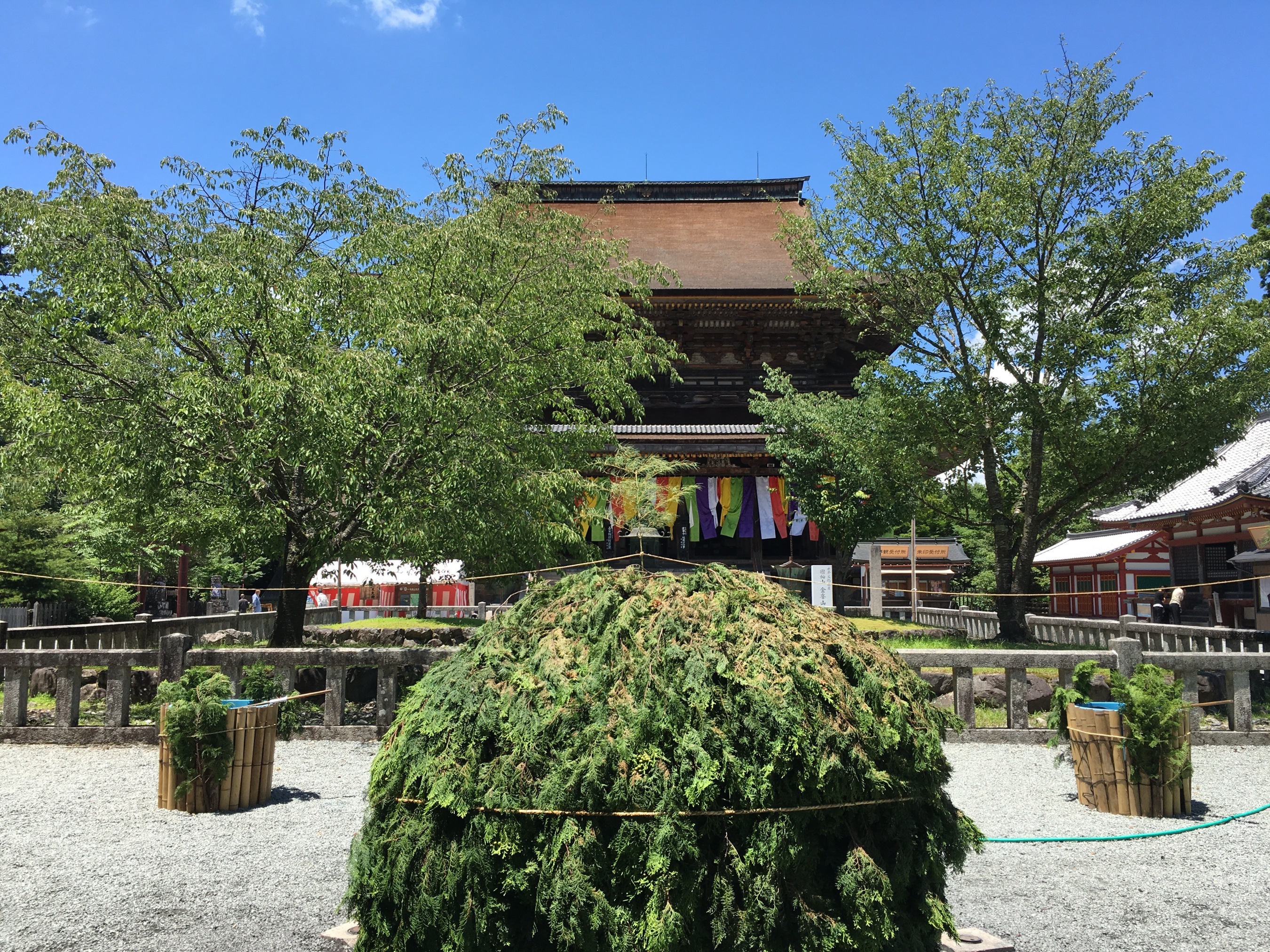
Kimpusen-ji Temple in Yoshino is the second largest ancient wooden building in the world, after Todai-ji Temple in Nara. While the Japanese stadium built with a wooden frame in 1998 is bigger than these temples, to me it does not give the same sense of ‘woodyness’. Certainly it does not have enormous pillars made of single tree trunks like this temple. The pile of cedar branches in the forecourt of the temple, which sit over a framework of wood, has been constructed in preparation for a Shugendo fire ceremony the following day.
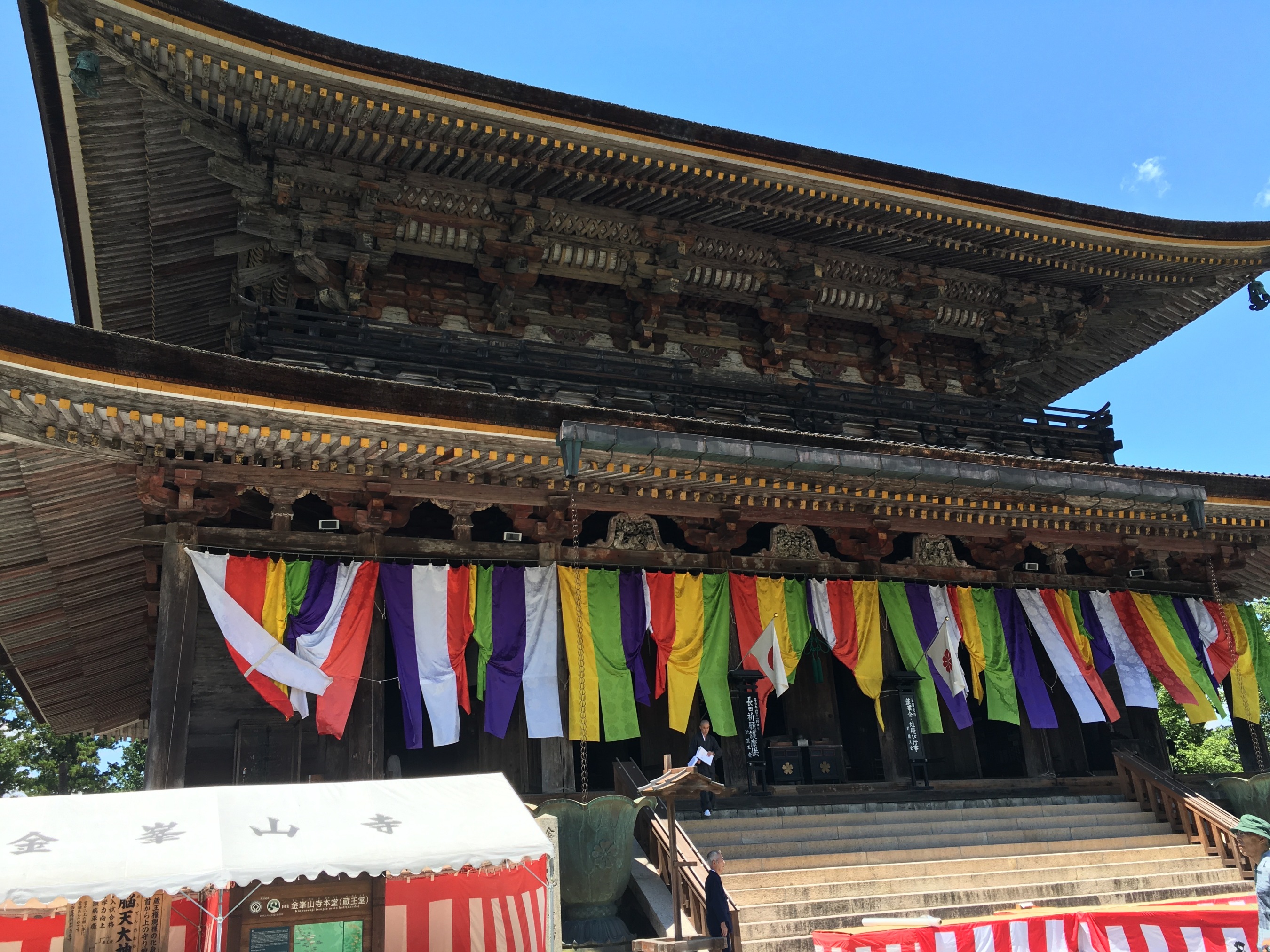
Here is a closer view of Kimpusen-ji Temple. The monk at the top of the stairs provides a scale. The five coloured banners are only displayed during Festivals or other major events. They represent the five Chinese elements of earth, water, fire, metal and wood according to one scholar (Sekimori 2013). In this instance the festival is called the Jumping Frog ceremony (Kaeru Tobi), a festival accompanied by the purifying Goma fire ceremony for which Shugendo practitioners are renowned. An image from the ceremony can be found below.
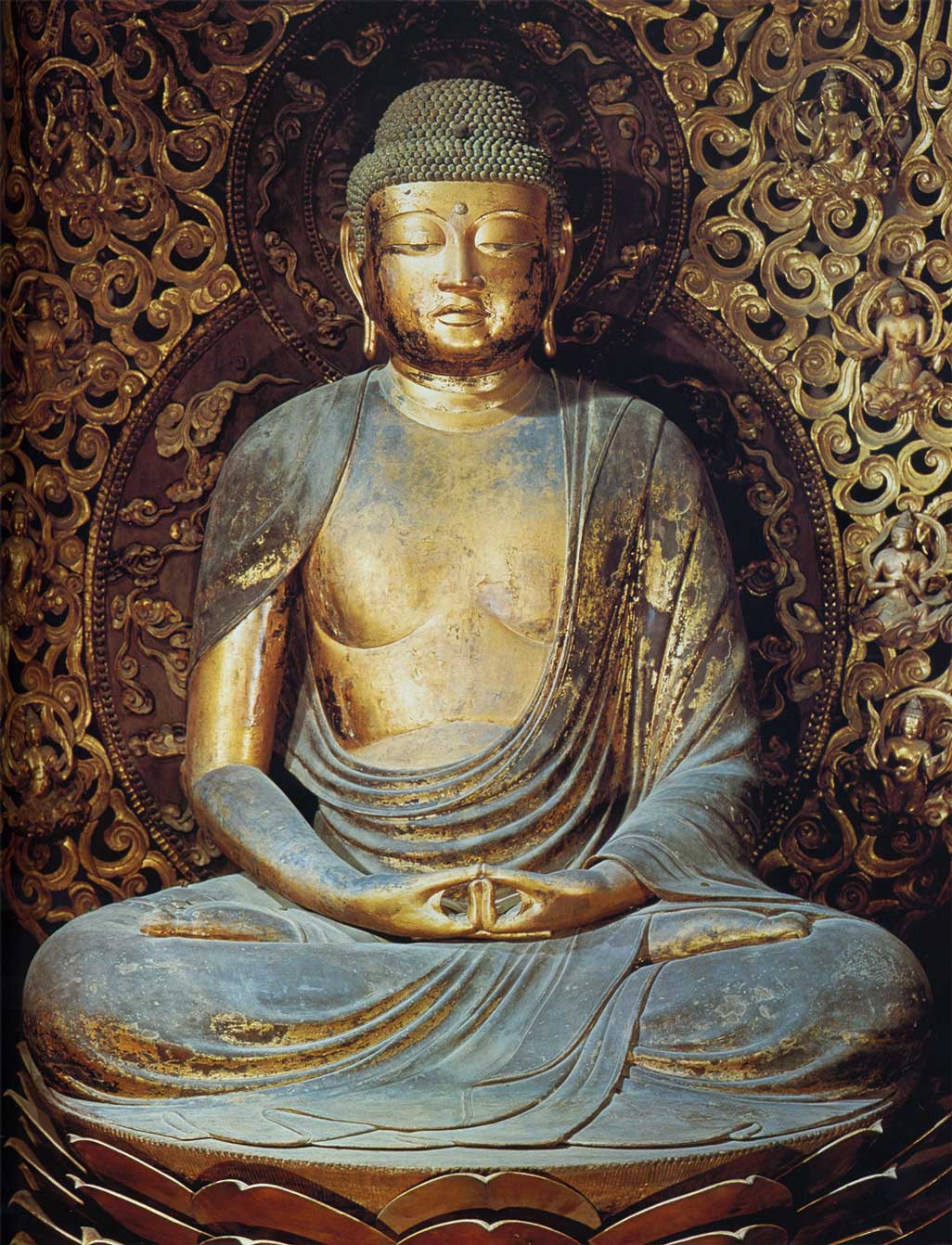
During my time in Japan I have seen many beautiful wooden religious statues in temples and Museums. They are another example of the ubiquity of the element of wood. The craftsmanship in the statues is a sight to behold. The most impressive was the 9.18 m tall statue of the 11-headed Kannon at Hase-dera Temple near Nara, carved from a single piece of camphor wood. I was fortunate to visit the temple when you were able to touch the feet of this majestic work. Mostly you are not allowed to take photos of these objects of worship. This image of the Amida Nyorai at Byodo-in Temple, which is around three metres tall and covered with gold leaf, is from Wikipedia commons. It exemplifies many of the captivating statues I have experienced.
Traditional wooden homes can be seen as you walk around the streets and travel on trains. The exteriors of modern houses are mainly new building materials, although internal wooden frames are still a feature. The modern materials have the benefit of being less combustible and are likely to be cheaper to build. Many people also live in apartment blocks made of concrete, like the one I am staying in.

Koshiya, a famous confectionary shop in Nijo (Kyoto), is largely made of wood in the traditional style.
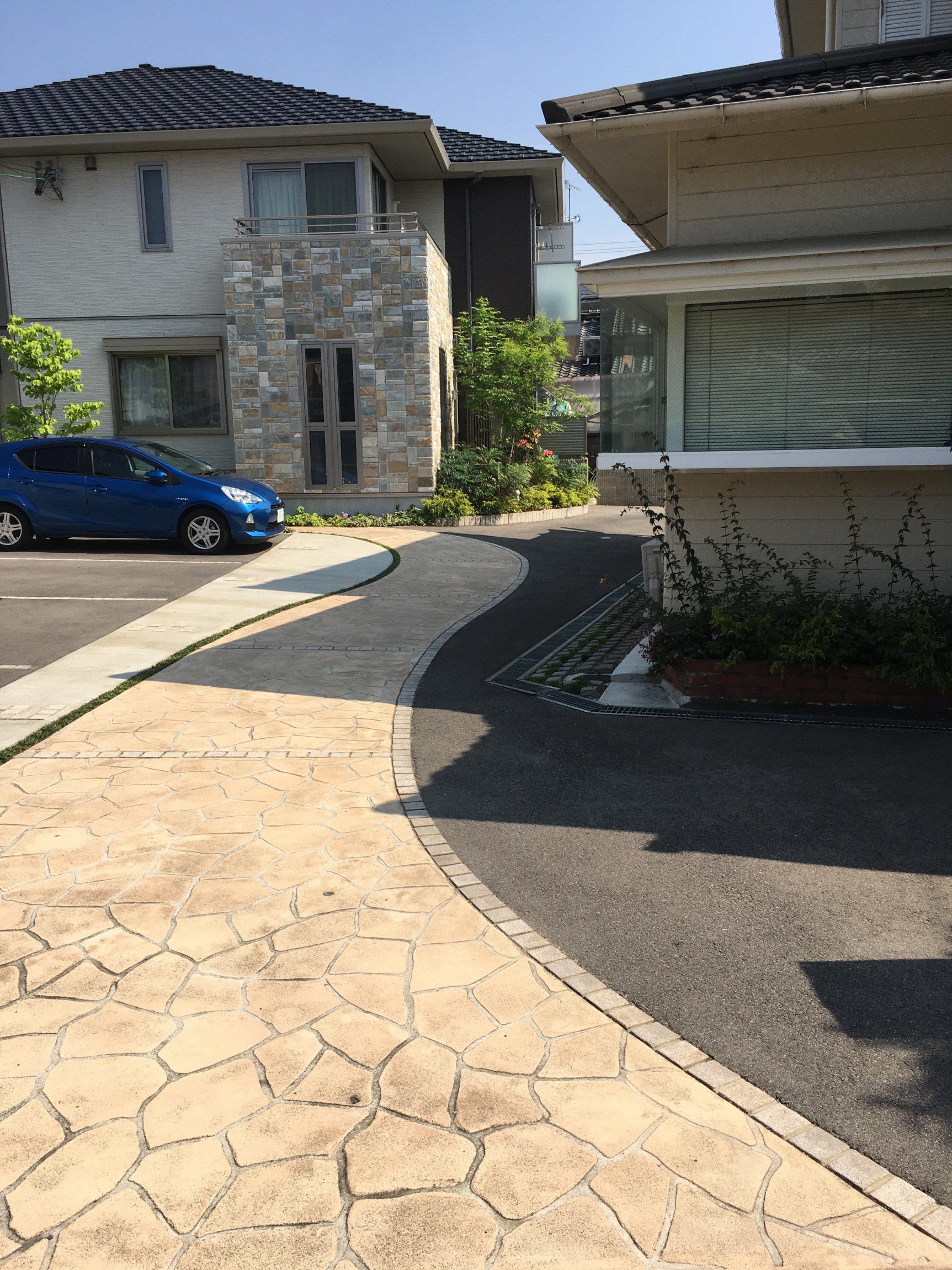
Most of the homes I have seen on my travels have exteriors constructed of modern materials, such as these homes in Nishioji. Traditional houses with wooden facades and interiors are found here and there in most major cities, possibly more commonly in rural areas. Their presence will depend on the history of natural disasters such as fires, earthquakes and tsunamis – and planning laws – amongst other things.
Shinto Shrines add another perspective to the use of wood as a building material. Some still participate in a renewal process called Sengu where wooden shrine buildings are rebuilt every 20 years. This relates to Shinto beliefs in impermanence and the renewal of nature. It is also a way of passing traditional building techniques from one generation to the next. The most famous shrine, of the few that still follow this practice, is Ise Grand Shrine in Mie Prefecture. The last Sengu was in 2013 which I was fortunate to experience. Last week I saw that the cedar shingle roof of Yoshimizu Shrine was being replaced. Shrines such as Izumo Shrine and Kamigamo Shrine have also done this recently. While these renewal cycles are longer than 20 years, they are still a major and expensive undertaking.
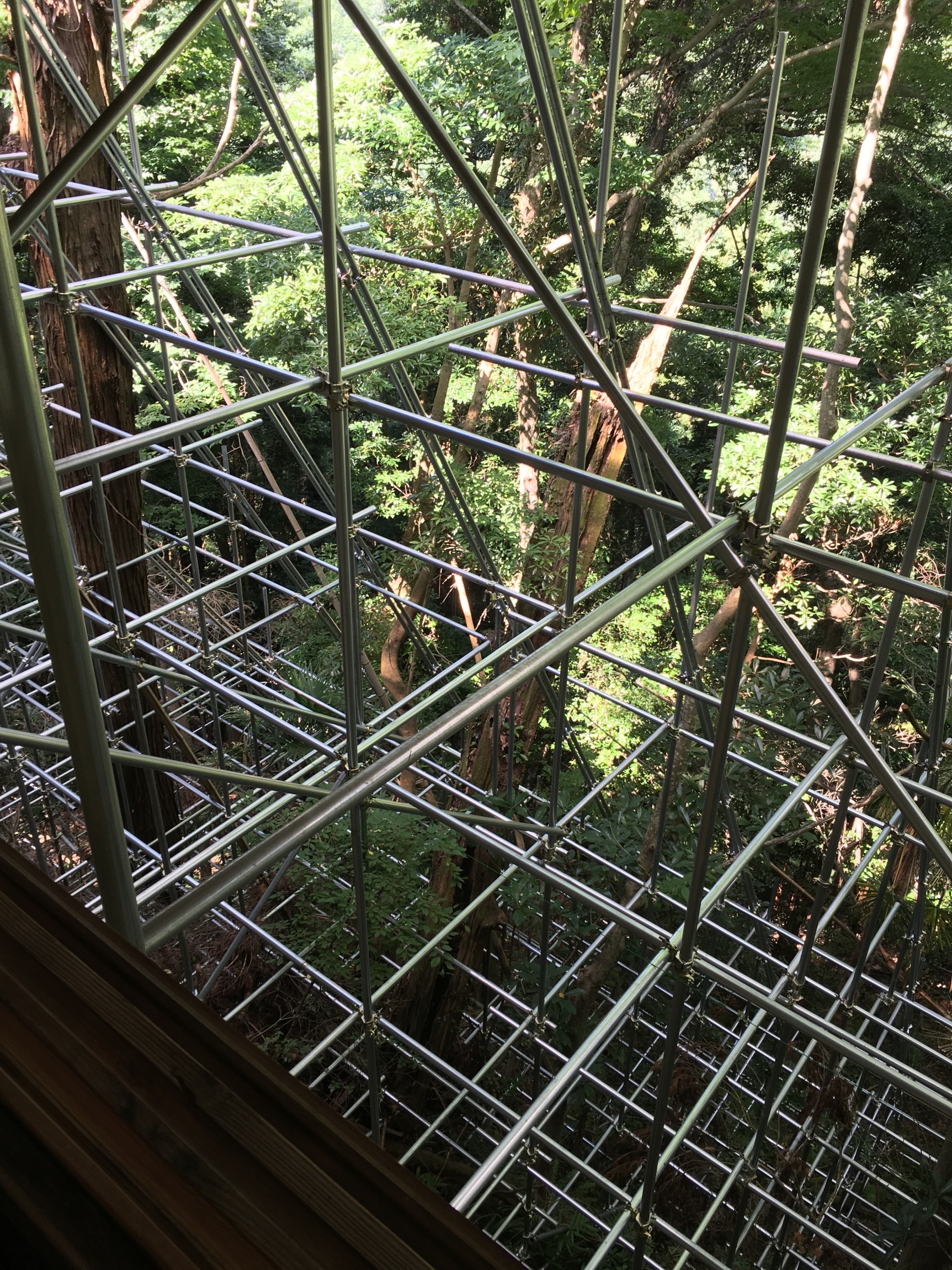
This is the scaffolding in place for the renewal of the cedar roof at Yoshimizu Shrine in Yoshino. The building sits on the top of a ridge so some serious infrastructure is required. The shrine is surrounded by evergreen forests and cherry trees, for which Yoshino is famous.
Charcoal, a by-product of wood, was primarily used for heating and cooking in Japan until after World War II when most people switched to fossil fuels. In addition to its continued use in buildings, wood is used today in activities such as firing pottery in traditional kilns, creating charcoal for the tea ceremony and use in some homes, and for soot made for the ink used in sumi paintings.
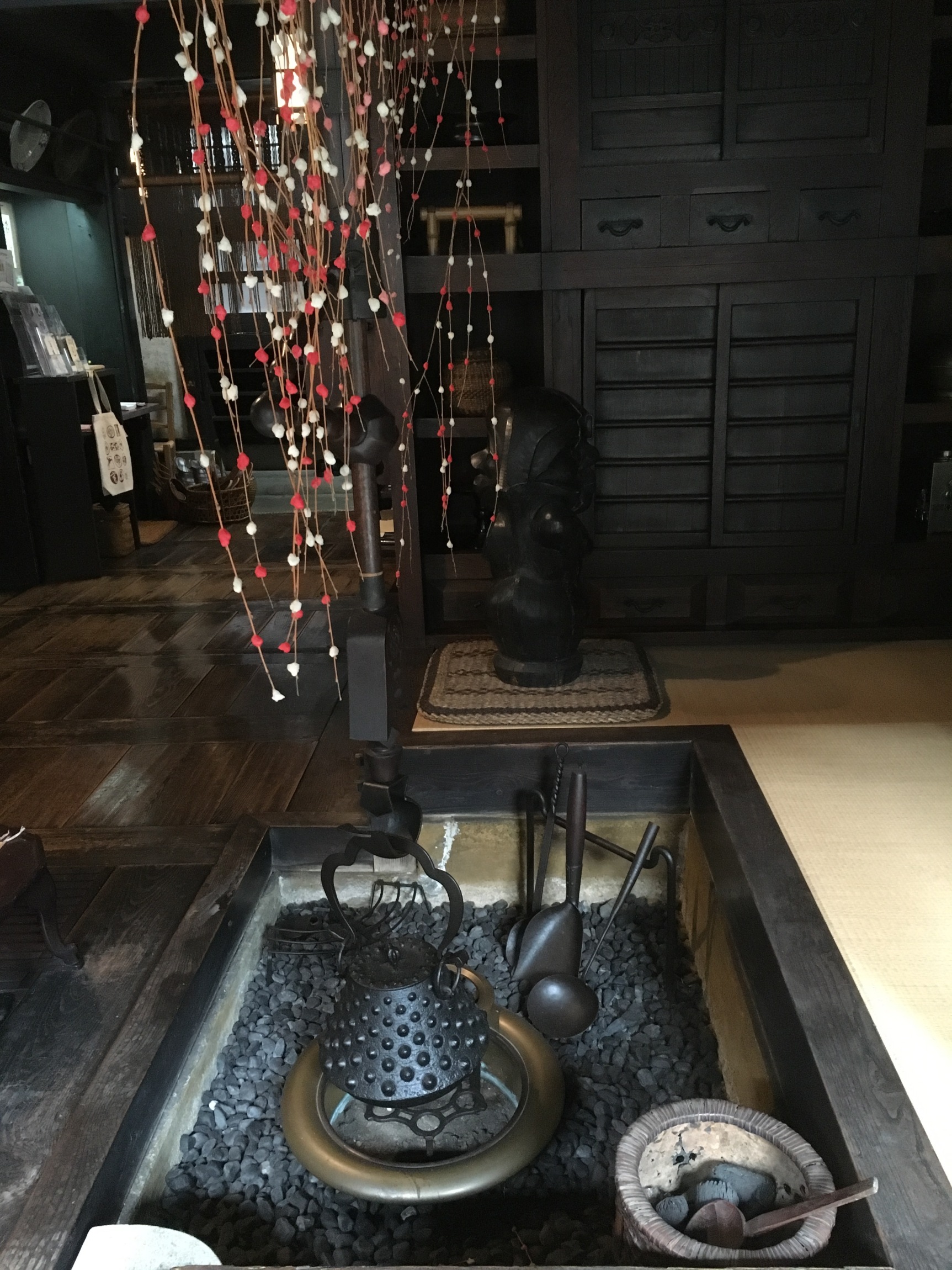
Traditional Japanese houses have a sunken hearth (irori) where food is cooked and water boiled. This example was found in the Kawai Kanjiro Museum in Kyoto, in a house built in 1937. The charcoal can be seen in the bottom right hand corner – it is the preferred fuel because it produces less smoke. Some irori were used to warm peoples legs by placing a wooden platform and blanket over the top. I’m not sure how feasible this would be with a split level hearth as shown here. Kotatsu, as they are known, adds a whole other dimension where wood, in the form of charcoal, generated fire. Modern kotatsu run on electricity, a safer and more constant source of heat.

Also seen at the Kawai Kanjiro Museum was this multi-chambered Noborigama kiln (step-climbing kiln), last fired up in 1971. The piles of wood used for the kiln can be seen along the side. This would have only been a small proportion of the amount used to get the kiln up to a sustained temperature of over 1200 degrees celsius. The sign at the front of the kiln says ‘Be careful of fire’, coincidentally very close to the title of my fourth blog! The largest working Noborigama kiln today is located in Shigaraki, in the southern portion of Shiga Prefecture. One day I plan to see one in action.
Wood is also used in disposable chopsticks or waribashi, of which I’ve been offered many pairs during my stay. I was astounded to read that 24-25 billion are consumed in Japan annually. That’s a lot of wood to harvest and dispose of, whatever way you look at it. The Japan Sustainability Forum provides a good overview of some of the cultural and environmental issues related to the use of waribashi. The article also includes some potential solutions. Written ten years ago, I wonder what advances have been made into decreasing the use of these disposable items?

Remembering to take your personal chopsticks with you is like remembering your non-plastic bags when you go shopping. They are both worth the effort. Currently most of the wood used to produce Japanese chopsticks comes from overseas. Several local groups are trying to reduce the use and impacts of waribashi consumption.
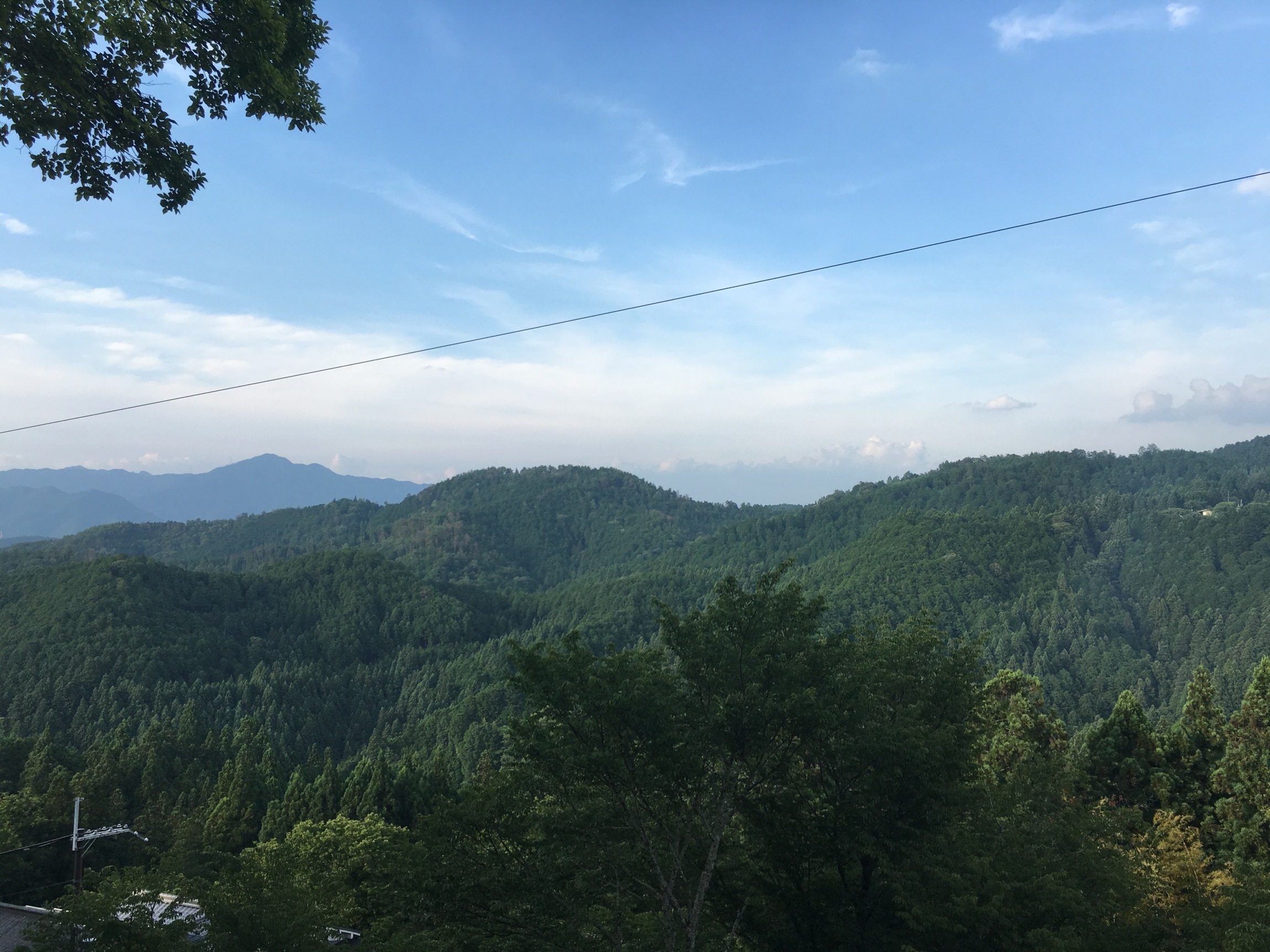
The use of forests for localised industries, and to provide energy and materials during and after World War II, put great pressure on the forests of Japan. Deforestation became a major issue which was addressed by extensive reforestation programs. It means that much of the greenness I have seen is provided by single species forests, as shown here in Yoshino – the plantations have the evenly spaced conical canopies. I have read that plantations now account for 40% of Japanese forests, a significant amount. Their management, and the continuing importation of timber from overseas, is a topic of some debate.

Fire festivals and rituals are common across Japan, with wood used at times to generate the flames (in Nara, a whole mountainside covered with grass is set alight in January). Like water, fire is an essential part of the religious landscape of Japan, related closely to purification. The Goma fire ceremony is unique to Shugendo. It was a great pleasure to see it performed on July 7th at Kinpusen-ji Temple in Yoshino. This image shows the water carrier and fan that are used to regulate the fire and smoke. The long stick with the forked branch at the end is being used to trace a symbolic letter (Swanson 1981). There were many references to the five Chinese elements in the ceremony, with fire being dominant.
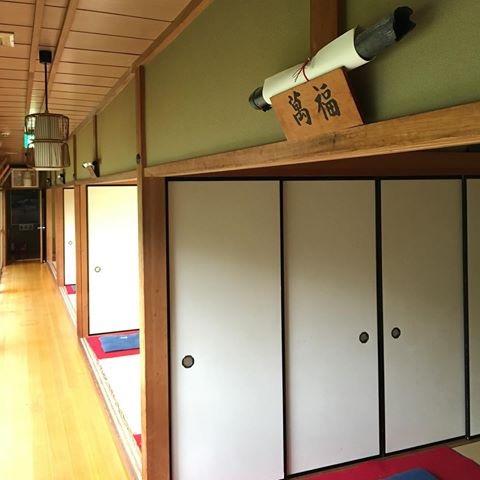
As this blog started, it will end with another intriguing image. In June I was fortunate to experience the Sal flower viewing and enjoy a Buddhist vegetarian lunch at Torin-in Temple in Kyoto. This is only possible two weeks in the year. When there I noticed many branches of charcoal wrapped in white paper sitting on the lintels. My photos did not do them justice so I am using this one from doumyouji on Instagram. He says that the charcoal is there as a protective charm. I would love to learn more about this practice.
I was very much taken with the use of wood in the construction of the early Japanese houses when we visited Japan in 2007. (Thanks to your generous birthday gift!) I was fascinated to discover that many of the buildings had been rebuilt several times, based on the original design. It makes sense to build contemporary homes from a material that is not so combustible, although the ancient temples win hands down as far as their timeless beauty. Talking about ‘hands down’, the graphic above of the interaction between elements reminded me of the hand game, ‘rock, paper, scissors’. A quick check on Wikipedia informs me that it is Chinese of origin and then taken on by the Japanese – of course!
LikeLike
Thanks for your comment. 🙂 As you say, apparently houses as well as shrines can be rebuilt on a regular basis. I’ve seen quite a few older style homes being renovated during my time in Kyoto. Wood can deteriorate quickly under certain conditions, so that’s another reason to rebuild. The Wu Xing cycle has been compared to rock, scissors, paper so you are spot on there! Wood is a beautiful material and brings a warmth to the constructions it is used in. Maintenance does need careful consideration though.
LikeLike
Pingback: Healing Spread: Question 2 – Seraphin Perihelion